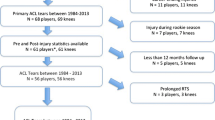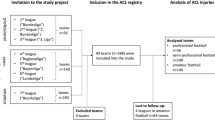Abstract
Background
There is evidence that early return to competition post-anterior cruciate ligament (ACL) injury increases risk of re-injury.
Aims
To compare subsequent ACL and other injury risks following ACL reconstruction for Australian Football League (AFL) players returning to competition at different times post-injury.
Methods
AFL players returning from ACL reconstruction in the 1992–2014 seasons were divided into three groups based on return to competition time (< 10, 10–12 and > 12 months). Non-reconstructed injuries and artificial ligament reconstructions were excluded. Subsequent ACL injury rates were calculated based on time since injury and number of return matches played. Risk of other knee and hamstring muscle injuries was also calculated.
Results
There were 233 ACL reconstructions that returned to play in the AFL during the time period under study and met our inclusion criteria. The per-game risk of subsequent ACL injury decreased with a log decay from 1.2 to 0.15% during the first 20 games back (R2 = 0.43). Players returning at > 12 months had higher overall percentage of future career games missed through subsequent ACL injuries (4.8% vs. 2.4%), and through all hamstring and knee injuries combined (12.6% vs. 8.4%) than players who returned at ≤ 12 months (both P < 0.001). Players returning at > 12 months had higher risk of knee cartilage (3.7%) and patella tendon (0.6%) injury than those returning at 10–12 months (1.5%, 0.1%, respectively).
Conclusion
Players returning from ACL reconstruction at greater than 12 months had significantly higher rates of future games missed through both subsequent ACL injuries and through all hamstring and knee injuries combined. It may be true that both early and late return to play lead to suboptimal outcomes compared to average return-to-play times.



Similar content being viewed by others
References
Lai, C. C. H., Feller, J. A., & Webster, K. E. (2018). Fifteen-year audit of anterior cruciate ligament reconstructions in the Australian Football League from 1999 to 2013: Return to play and subsequent ACL injury. The American Journal of Sports Medicine,46(14), 3353–3360.
Orchard, J., Seward, H., McGivern, J., & Hood, S. (1999). Rainfall, evaporation and the risk of non-contact anterior cruciate ligament injury in the Australian Football League. Medical Journal of Australia,170(7), 304–306.
Kvist, J., Kartus, J., Karlsson, J., & Forssblad, M. (2014). Results from the Swedish national anterior cruciate ligament register. Arthroscopy,30(7), 803–810.
Lai, C. C. H., Ardern, C. L., Feller, J. A., & Webster, K. E. (2018). Eighty-three per cent of elite athletes return to preinjury sport after anterior cruciate ligament reconstruction: A systematic review with meta-analysis of return to sport rates, graft rupture rates and performance outcomes. British Journal of Sports Medicine,52(2), 128–138.
Lind, M., Menhert, F., & Pedersen, A. B. (2009). The first results from the Danish ACL reconstruction registry: Epidemiologic and 2 year follow-up results from 5,818 knee ligament reconstructions. Knee Surgery, Sports Traumatology, Arthroscopy,17(2), 117–124.
Moses, B., Orchard, J., & Orchard, J. (2012). Systematic review: Annual incidence of ACL injury and surgery in various populations. Research in Sports Medicine (Print),20(3–4), 157–179.
Saw, R., Finch, C. F., Samra, D., et al. (2017). Injuries in Australian rules football: An overview of injury rates, patterns, and mechanisms across all levels of play. Sports Health,10(3), 208–216.
Davies, G. J., McCarty, E., Provencher, M., & Manske, R. C. (2017). ACL return to sport guidelines and criteria. Current Reviews in Musculoskeletal Medicine,10(3), 307–314.
Barber-Westin, S. D., & Noyes, F. R. (2011). Factors used to determine return to unrestricted sports activities after anterior cruciate ligament reconstruction. Arthroscopy: The Journal of Arthroscopic & Related Surgery,27(12), 1697–1705.
Myer, G. D., Martin, L., Jr., Ford, K. R., et al. (2012). No association of time from surgery with functional deficits in athletes after anterior cruciate ligament reconstruction: Evidence for objective return-to-sport criteria. The American Journal of Sports Medicine,40(10), 2256–2263.
Myklebust, G. (2005). Return to play guidelines after anterior cruciate ligament surgery. British Journal of Sports Medicine,39(3), 127–131.
Petersen, W., & Zantop, T. (2013). Return to play following ACL reconstruction: Survey among experienced arthroscopic surgeons (AGA instructors). Archives of Orthopaedic and Trauma Surgery,133(7), 969–977.
Zaffagnini, S., Grassi, A., Serra, M., & Marcacci, M. (2015). Return to sport after ACL reconstruction: How, when and why? A narrative review of current evidence. Joints,3(1), 25–30.
Webster, K. E., & Feller, J. A. (2018). Return to level I sports after anterior cruciate ligament reconstruction: Evaluation of age, sex, and readiness to return criteria. Orthopaedic Journal of Sports Medicine,6(8), 2325967118788045.
Grindem, H., Snyder-Mackler, L., Moksnes, H., Engebretsen, L., & Risberg, M. A. (2016). Simple decision rules can reduce reinjury risk by 84% after ACL reconstruction: The Delaware-Oslo ACL cohort study. British Journal of Sports Medicine,50(13), 804–808.
Saw, R., Finch, C. F., Samra, D., et al. (2018). Injuries in Australian Rules Football: An overview of injury rates, patterns, and mechanisms across all levels of play. Sports Health,10(3), 208–216.
Iliadis, D. P., Bourlos, D. N., Mastrokalos, D. S., Chronopoulos, E., & Babis, G. C. (2016). LARS artificial ligament versus ABC purely polyester ligament for anterior cruciate ligament reconstruction. Orthopaedic Journal of Sports Medicine,4(6), 2325967116653359.
Evans, J. D. (1996). Straightforward statistics for the behavioral sciences. Pacific Grove: Brooks/Cole Pub. Co.
Liptak, M. G., & Angel, K. R. (2017). Return to play and player performance after anterior cruciate ligament injury in elite Australian rules football players. Orthopaedic Journal of Sports Medicine,5(6), 2325967117711885.
Orchard, J., Seward, H., McGivern, J., & Hood, S. (2001). Intrinsic and extrinsic risk factors for anterior cruciate ligament injury in Australian footballers. The American Journal of Sports Medicine,29(2), 196–200.
Waldén, M., Hägglund, M., Magnusson, H., & Ekstrand, J. (2016). ACL injuries in men’s professional football: A 15-year prospective study on time trends and return-to-play rates reveals only 65% of players still play at the top level 3 years after ACL rupture. British Journal of Sports Medicine,50(12), 744.
Toohey, L. A., Drew, M. K., Cook, J. L., Finch, C. F., & Gaida, J. E. (2017). Is subsequent lower limb injury associated with previous injury? A systematic review and meta-analysis. British Journal of Sports Medicine,51(23), 1670.
Walden, M., Hagglund, M., & Ekstrand, J. (2006). High risk of new knee injury in elite footballers with previous anterior cruciate ligament injury. British journal of sports medicine.,40(2), 158–162. (discussion 158–162).
Takeda, T., Matsumoto, H., & Fujikawa, K. (1997). Influence of secondary damage to menisci and articular cartilage on return to sports after anterior cruciate ligament reconstruction. Journal of Orthopaedic Science, 2(4), 215–221.
Oiestad, B. E., Engebretsen, L., Storheim, K., & Risberg, M. A. (2009). Knee osteoarthritis after anterior cruciate ligament injury: A systematic review. The American Journal of Sports Medicine,37(7), 1434–1443.
Fok, A. W., & Yau, W. P. (2013). Delay in ACL reconstruction is associated with more severe and painful meniscal and chondral injuries. Knee Surgery, Sports Traumatology, Arthroscopy,21(4), 928–933.
Ardern, C. L., Webster, K. E., Taylor, N. F., & Feller, J. A. (2011). Return to the preinjury level of competitive sport after anterior cruciate ligament reconstruction surgery: Two-thirds of patients have not returned by 12 months after surgery. The American Journal of Sports Medicine,39(3), 538–543.
Tulloch, S. J., Devitt, B. M., Porter, T., et al. (2019). Primary ACL reconstruction using the LARS device is associated with a high failure rate at minimum of 6-year follow-up. Knee Surgery, Sports Traumatology, Arthroscopy,27, 3626–3632.
Narducci, E., Waltz, A., Gorski, K., Leppla, L., & Donaldson, M. (2011). The clinical utility of functional performance tests within one-year post-ACL reconstruction: A systematic review. International Journal of Sports Physical Therapy,6(4), 333–342.
Burland, J. P., Toonstra, J., Werner, J. L., Mattacola, C. G., Howell, D. M., & Howard, J. S. (2018). Decision to return to sport after anterior cruciate ligament reconstruction. Part I: A qualitative investigation of psychosocial factors. Journal of Athletic Training,53(5), 452–463.
Acknowledgements
The authors would like to acknowledge the support of the Australian Football League (AFL) Research Board.
Funding
Not externally funded.
Author information
Authors and Affiliations
Corresponding author
Ethics declarations
Conflict of interest
The authors declare that they have no conflict of interest.
Ethical standard statement
The injury and player match data were extracted from the AFL injury database with all identifying features removed. The study methods were approved by the Human Research Ethics Committee of Sydney University, Sydney, Australia. Protocol Number: 2018/512.
Informed consent
For this type of study, informed consent is not required.
Additional information
Publisher's Note
Springer Nature remains neutral with regard to jurisdictional claims in published maps and institutional affiliations.
Rights and permissions
About this article
Cite this article
Chaker Jomaa, M., Gultekin, S., Orchard, J. et al. Australian Footballers Returning from Anterior Cruciate Ligament Reconstruction Later than 12 Months have Worse Outcomes. JOIO 54, 317–323 (2020). https://doi.org/10.1007/s43465-020-00092-9
Received:
Accepted:
Published:
Issue Date:
DOI: https://doi.org/10.1007/s43465-020-00092-9




